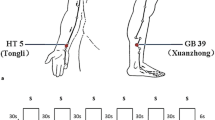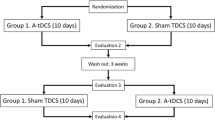Abstract
Objective
To explore brain activations associated with electroacupuncture simulation at Tongli (HT 5) and its comparison with brain activations during picture-naming task.
Methods
Twenty healthy subjects were enrolled in this study. Half of them received electroacupuncture stimulation at HT 5 (ACUP group) and the other half of them received stimulation at a nonmeridian sham acupoint (SHAM group). All subjects performed picture-naming task. Each subject finished two runs of functional magnetic resonance imaging examinations in one session and picture-naming task was performed before electroacupuncture stimulation. Subjective brain activations were obtained using generalized linear model and inter-group analyses were performed after that.
Results
The electroacupuncture stimulation at HT 5 induced significant brain activations in both the anterior and posterior language regions, including the left inferior frontal gyrus, which was in consistent with activations induced during picture-naming task. Group analysis showed a tendency of increased activation of ACUP group in left inferior frontal gyrus compared with SHAM group (P<0.05 FDR corrected).
Conclusions
Electroacupuncture treatment at the acupoint HT 5 has modulation effect on typical language-implicated brain regions in healthy subjects, which provides supporting evidence for beneficial effects of needling at HT 5 for recovery of language function in aphasia.
Similar content being viewed by others
References
Napadow V, Makris N, Liu J, Kettner NW, Kwong KK, Hui KK. Effects of electroacupuncture versus manual acupuncture on the human brain as measured by fMRI. Hum Brain Mapp 2005;24:193–205.
Zhao JM, Lu JH, Yi XJ, Chen XK, Chen YH, Tang WJ, et al. Comparison of electroacupuncture and moxibustion on brain-gut function in patients with diarrhea-predominant irritable bowel syndrome: a randomized controlled trial. Chin J Integr Med 2015;21:855–865.
Zhang CX, Guo LK. Dalitong Granule combined with electroacupuncture in the treatment of functional dyspepsia: a randomized controlled trial. Chin J Integr Med 2015;21:743–750.
Wang WD, Lu XY, Ng SM, Hong L, Zhao Y, Lin YN, et al. Effects of electro-acupuncture on personality traits in depression: a randomized controlled study. Chin J Integr Med 2013;19:777–782.
Zhao ZQ, Jia SW, Hu S, Sun W. Evaluating the effectiveness of electro-acupuncture as a treatment for childhood autism using single photon emission computed tomography. Chin J Integr Med 2014;20:19–23.
Jung W, Kwon S, Park S, Moon S. Can combination therapy of conventional and oriental medicine improve poststroke aphasia? Comparative, observational, pragmatic study. Evid Based Complement Alternat Med 2012;2012:654604.
Wu MT, Sheen JM, Chuang KH, Yang P, Chin SL, Tsai CY, et al. Neuronal specificity of acupuncture response: a fMRI study with electroacupuncture. Neuroimage 2002;16:1028–1037.
Li L, Liu H, Li YZ, Xu JY, Shan BC, Gong D, et al. The human brain response to acupuncture on samemeridian acupoints: evidence from an fMRI study. J Altern Complement Med 2008;14:673–678.
Feng YY, Bai LJ, Zhang WS, Ren YS, Xue T, Wang H, et al. Investigation of acupoint specificity by whole brain functional connectivity analysis from fMRI data. Conf Proc IEEE Eng Med Biol Soc 2011;2011:2784–2787.
Li LL, Qin W, Bai LJ, Tian J. Exploring vision-related acupuncture point specificity with multivoxel pattern analysis. Magn Reson Imag 2010;28:380–387.
Jeun SS, Kim JS, Kim BS, Park SD, Lim EC, Choi GS, et al. Acupuncture stimulation for motor cortex activities: a 3T fMRI study. Am J Chin Med 2005;33:573–578.
Wang W, Liu L, Zhi X, Huang JB, Liu DX, Wang H, et al. Study on the regulatory effect of electro-acupuncture on Hegu point (LI 4) in cerebral response with functional magnetic resonance imaging. Chin J Integr Med 2007;13:10–16.
Li G, Liu HL, Cheung RT, Hung YC, Wong KK, Shen GG, et al. An fMRI study comparing brain activation between word generation and electrical stimulation of language-implicated acupoints. Hum Brain Mapp 2003;18:233–238.
Li G, Yang ES. An fMRI study of acupuncture-induced brain activation of aphasia stroke patients. Complement Ther Med 2011;19 (Suppl) 1:S49–S59.
Sun Y, Xue SA, Zuo Z. Acupuncture therapy on apoplectic aphasia rehabilitation. J Tradit Chin Med 2012;32:314–321.
Chang JL, Gao Y. Electroacupuncture in language-related grouped acupoints and post-stroke anandia induced by injury of temple apical and occipital junctional zone in one case: a linguistic review and imaging investigation. J Beijing Univ Tradit Chin Med (Clin Med, Chin) 2012;19(4):1–5.
Wu F, Yang WZ, Zhao N, Sheng YX, Ye BY, Liu XL. Impacts on motor aphasia after cerebral infarction treated with acupuncture at Tongli (HT 5) and speech rehabilitation training in the patients. Chin J Integr Med Cardio/ Cerebrovasc Dis (Chin) 2010;3:290–292.
Xiao J, Zhang H, Chang JL, Zhou L, Tan ZJ, Zhong HZ, et al. Effects of electro-acupuncture at Tongli (HT 5) and Xuanzhong (GB 39) acupoints from functional magnetic resonance imaging evidence. Chin J Integr Med 2016;22:846–854.
Huang W, Pach D, Napadow V, Park K, Long X, Neumann J, et al. Characterizing acupuncture stimuli using brain imaging with fMRI—a systematic review and meta-analysis of the literature. PLoS One 2012;7:e32960.
Rong PJ, Zhao JJ, Gao JH, Li X, Li SY, Ben H, et al. Progress of research on specificity of meridian acupoint efficacy. Chin J Integr Med 2013;19:889–893.
Oldfield RC. The assessment and analysis of handedness: the Edinburgh inventory. Neuropsychologia 1971;9:97–113.
Hui KK, Marina O, Liu J, Rosen BR, Kwong KK. Acupuncture, the limbic system, and the anticorrelated networks of the brain. Auton Neurosci 2010;157:81–90.
Kong J, Gollub R, Huang T, Polich G, Napadow V, Hui K, et al. Acupuncture De Qi, from qualitative history to quantitative measurement. J Altern Complement Med 2007;13:1059–1070.
Hui KK, Liu J, Marina O, Napadow V, Haselgrove C, Kwong KK, et al. The integrated response of the human cerebrocerebellar and limbic systems to acupuncture stimulation at ST 36 as evidenced by fMRI. Neuroimage 2005;27:479–496.
Bates E, D’Amico S, Jacobsen T, Szekely A, Andonova E, Devescovi A, et al. Timed picture naming in seven languages. Psychon Bull Rev 2003;10:344–380.
Friston KJ, Frith CD, Turner R, Frackowiak RS. Characterizing evoked hemodynamics with fMRI. Neuroimage 1995;2:157–165.
Binder JR, Desai RH, Graves WW, Conant LL. Where is the semantic system? A critical review and meta-analysis of 120 functional neuroimaging studies. Cereb Cortex 2009;19:2767–2796.
Tyler LK Marslen-Wilson W. Fronto-temporal brain systems supporting spoken language comprehension. Philos Trans R Soc Lond B Biol Sci 2008;363:1037–1054.
Abrams DA, Ryali S, Chen T, Balaban E, Levitin DJ, Menon V. Multivariate activation and connectivity patterns discriminate speech intelligibility in Wernicke’s, Broca’s, and Geschwind’s areas. Cereb Cortex 2013;23:1703–1714.
Price CJ. A review and synthesis of the first 20 years of PET and fMRI studies of heard speech, spoken language and reading. Neuroimage 2012;62:816–847.
Fang JL, Krings T, Weidemann J, Meister IG,Thron A. Functional MRI in healthy subjects during acupuncture: different effects of needle rotation in real and false acupoints. Neuroradiology 2004;46:359–262.
Hui KK, Liu J, Makris N, Gollub RL, Chen AJ, Moore CI, et al. Acupuncture modulates the limbic system and subcortical gray structures of the human brain: evidence from fMRI studies in normal subjects. Hum Brain Mapp 2000;9:13–25.
Kong J, Kaptchuk TJ, Webb JM, Kong JT, Sasaki Y, Polich GR, et al. Functional neuroanatomical investigation of vision-related acupuncture point specificity—a multisession fMRI study. Hum Brain Mapp 2009;30:38–46.
Deng G, Hou BL, Holodny AI, Cassileth BR. Functional magnetic resonance imaging (fMRI) changes and saliva production associated with acupuncture at LI-2 acupuncture point: a randomized controlled study. BMC Complement Altern Med 2008;8:37.
Author information
Authors and Affiliations
Corresponding author
Additional information
Supported by the Hundred Talents Program of Chinese Academy of Sciences (No. Y14408), Shenzhen Science and Technology Program (No. JC201005270293A, JC201104220257A and 201101017), and National Natural Science Foundation of China (No. 81471738)
Rights and permissions
About this article
Cite this article
Li, Ll., Liu, Xw., Wu, F. et al. Electroacupuncture Stimulation of Language-Implicated Acupoint Tongli (HT 5) in Healthy Subjects: An fMRI Evaluation Study. Chin. J. Integr. Med. 24, 822–829 (2018). https://doi.org/10.1007/s11655-017-2924-8
Accepted:
Published:
Issue Date:
DOI: https://doi.org/10.1007/s11655-017-2924-8




